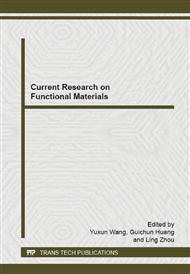[1]
M. Endo, C. Kim, K. Nishimura, et al., Recent development of carbon materials for Li ion batteries, Carbon, 38 (2000) 183-197.
DOI: 10.1016/s0008-6223(99)00141-4
Google Scholar
[2]
S. Flandrois, B. Simon, Carbon materials for lithium-ion rechargeable batteries, Carbon, 37 (1999) 165-180.
DOI: 10.1016/s0008-6223(98)00290-5
Google Scholar
[3]
M. Wakihara, O. Yamamoto, Lithium ion batteries: fundamentals and performance, Kodansha, (1998).
Google Scholar
[4]
B. A. Boukamp, G. C. Lesh, R. A. Huggins, All-solid lithium electrodes with mixed-conductor matrix, J. Electrochem. Soc., 128 (1981) 725-729.
DOI: 10.1149/1.2127495
Google Scholar
[5]
J. M. Tarascon, M. Armand, Issues and challenges facing rechargeable lithium batteries, Nature, 414 (2001) 359-367.
DOI: 10.1038/35104644
Google Scholar
[6]
J. E. Fischer, Storing energy in carbon nanotubes, Chem. Innov., 30 (2000) 21-27.
Google Scholar
[7]
M. Winter, J. O. Besenhard, M. E. Spahr, et al., Insertion electrode materials for rechargeable lithium batteries, Adv. Mater., 10 (1998) 725-763.
DOI: 10.1002/(sici)1521-4095(199807)10:10<725::aid-adma725>3.0.co;2-z
Google Scholar
[8]
G. Yang, F. P. Cai, B. Jiang, et al., Research progresses of MWCNTs modified LiFePO4 cathode material for Li-ion batteries, Journal of Functional Materials, 43(z1) (2012) 0-0.
Google Scholar
[9]
Y. T. Wang, Z. D. Liu, Z. Y. Xue, et al., The rectification effect of the carbon nanotube / electrolyte interface, Journal of Functional Materials, 43(04) (2012) 473-475.
Google Scholar
[10]
B. Gao, A. Kleinhammes, X. P. Tang, et al., Electrochemical intercalation of single-walled carbon nanotubes with lithium, Chem. Phys. Lett., 307 (1999) 153-157.
DOI: 10.1016/s0009-2614(99)00486-8
Google Scholar
[11]
H. Shimoda, B. Gao, X. P. Tang, et al., Lithium intercalation into opened single-wall carbon nanotubes: Storage capacity and electronic properties, Phys. Rev. Lett., 88 (2002) 015502.
DOI: 10.1103/physrevlett.88.015502
Google Scholar
[12]
S. W. Lee, N. Yabuuchi, B. M. Gallant, et al., High-power lithium batteries from functionalized carbon-nanotube electrodes, Nat. Nanotechnol., 5 (2010) 531-537.
DOI: 10.1038/nnano.2010.116
Google Scholar
[13]
T. Kar, J. Pattanayak, S. Scheiner, Insertion of lithium ions into carbon nanotubes: An ab initio study, J. Phys. Chem. A, 105 (2001) 10397-10403.
DOI: 10.1021/jp011698l
Google Scholar
[14]
C. Garau, A. Frontera, D. Quinonero, et al., Ab initio investigations of lithium diffusion in single-walled carbon nanotubes, Chem. Phys., 297 (2004) 85-91.
DOI: 10.1016/j.chemphys.2003.10.004
Google Scholar
[15]
C. Garau, A. Frontera, D. Quinonero, et al., Lithium diffusion in single-walled carbon nanotubes: a theoretical study, Chem. Phys. Lett., 374 (2003) 548-555.
DOI: 10.1016/s0009-2614(03)00748-6
Google Scholar
[16]
A. Udomvech, T. Kerdcharoen, T. Osotchan, First principles study of Li and Li+ adsorbed on carbon nanotube: Variation of tubule diameter and length, Chem. Phys. Lett., 406 (2005) 161-166.
DOI: 10.1016/j.cplett.2005.02.084
Google Scholar
[17]
A. Udomvech, T. Kepdcharoen, Theoretical investigation of lithium-atom insertion into ultra-small diameter carbon nanotubes, J. Korean Phys. Soc., 52 (2008) 1350-1354.
DOI: 10.3938/jkps.52.1350
Google Scholar
[18]
Y. W. Wen, H. J. Liu, X. J. Tan, et al., First-principles study of alkali-atom doping in a series of zigzag and armchair carbon nanotubes, J. Appl. Phys., 107 (2010) 034312.
DOI: 10.1063/1.3291128
Google Scholar
[19]
J. Zhao, A. Buldum, J. Han, et al., First-principles study of Li-intercalated carbon nanotube ropes, Phys. Rev. Lett., 85 (2000) 1706-1709.
DOI: 10.1103/physrevlett.85.1706
Google Scholar
[20]
V. Meunier, J. Kephart, C. Roland, et al., Ab initio investigations of lithium diffusion in carbon nanotube systems, Phys. Rev. Lett., 88 (2002) 075506.
DOI: 10.1103/physrevlett.88.075506
Google Scholar
[21]
B. Song, J. W. Yang, J. J. Zhao, et al., Intercalation and diffusion of lithium ions in a carbon nanotube bundle by ab initio molecular dynamics simulations, Energy Environ. Sci., 4 (2011) 1379-1384.
DOI: 10.1039/c0ee00473a
Google Scholar
[22]
J. M. Soler, E. Artacho, J. D. Gale, et al., The SIESTA method for ab initio order-N materials simulation, J. Phys: Condens. Matter, 14 (2002) 2745-2779.
DOI: 10.1088/0953-8984/14/11/302
Google Scholar
[23]
D. M. Ceperley, B. J. Alder, Ground-state of the electron-gas by a stochastic method, Phys. Rev. Lett., 45 (1980) 566-569.
DOI: 10.1103/physrevlett.45.566
Google Scholar
[24]
J. P. Perdew, A. Zunger, Self-interaction correction to density-functional approximations for many-electron systems, Phys. Rev. B, 23 (1981) 5048-5079.
DOI: 10.1103/physrevb.23.5048
Google Scholar
[25]
N. Troullier, J. L. Martins, Efficient pseudopotentials for plane-wave calculations, Phys. Rev. B, 43 (1991) 1993-(2006).
DOI: 10.1103/physrevb.43.1993
Google Scholar
[26]
L. Kleinman, D. M. Bylander, Efficacious form for model pseudopotentials, Phys. Rev. Lett., 48 (1982) 1425-1428.
DOI: 10.1103/physrevlett.48.1425
Google Scholar
[27]
D. SanchezPortal, P. Ordejon, E. Artacho, et al., Density-functional method for very large systems with LCAO basis sets, Int. J. Quantum. Chem., 65 (1997) 453-461.
DOI: 10.1002/(sici)1097-461x(1997)65:5<453::aid-qua9>3.0.co;2-v
Google Scholar
[28]
M. R. Hestenes, E. Stiefel, Methods of Conjugate Gradients for Solving Linear Systems, J. Res. Natl. Bur. Stand., 49 (1952) 409-436.
DOI: 10.6028/jres.049.044
Google Scholar


